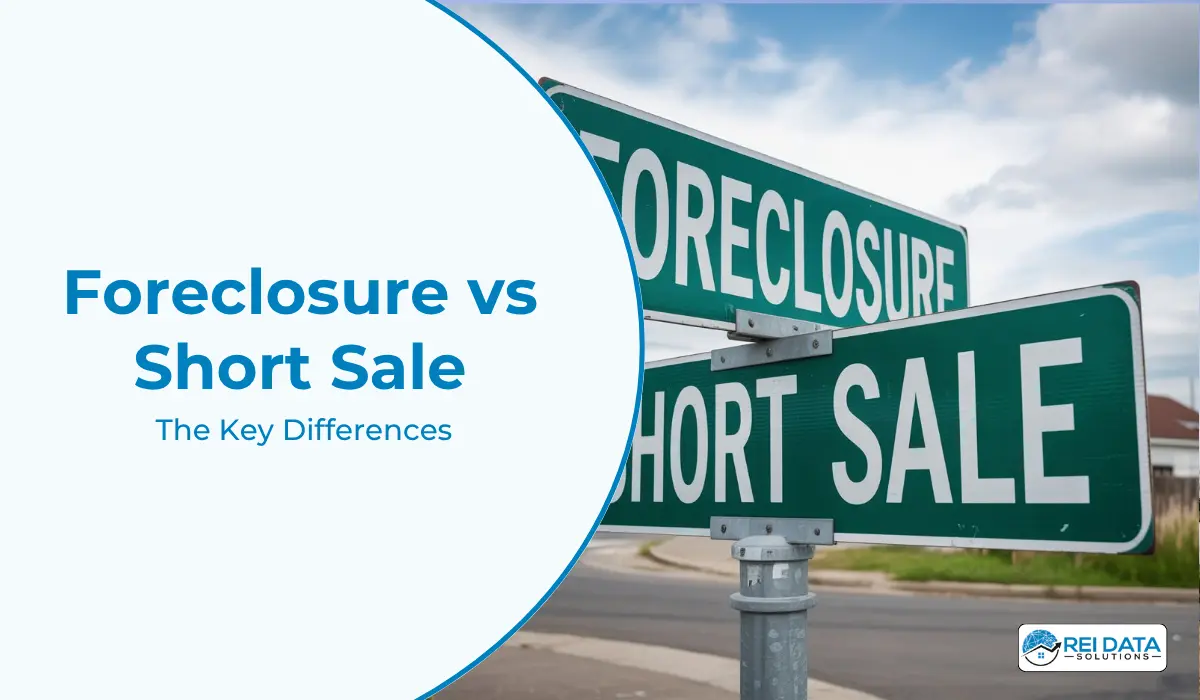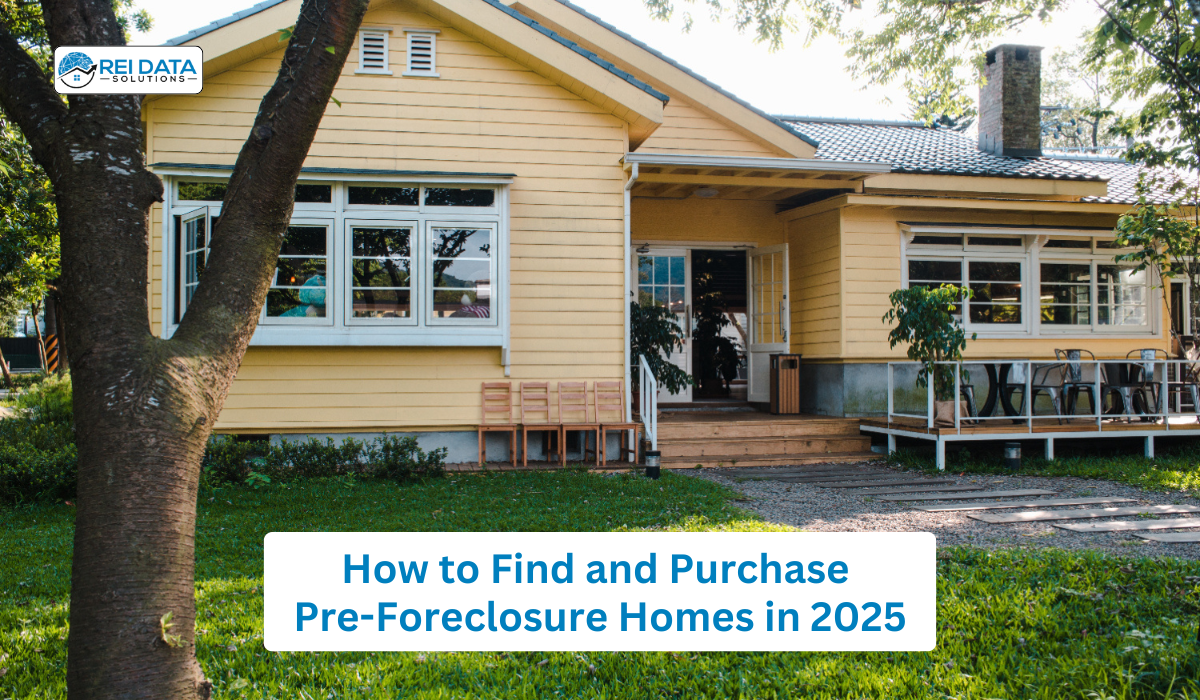Foreclosure is a process through which the lender takes possession of a property for which the borrower has failed to repay the mortgage amount. After repossessing the home/property, the lender can sell it as a foreclosure sales listing to recover the loan amount.
Investing in pre-foreclosure or foreclosure homes and selling at the right price may unlock superb deals for real estate investors since homeowners are motivated to relieve financial burdens and lenders are eager to recover the amount after repossession. 2022 figures reveal more than 320,000 properties had foreclosure activities, almost 0.23% of all houses in the US.
Luckily, after the 2007–2009 mortgage crisis, the foreclosure listings and acquisition process went a lot smoother. Today, it’s almost similar to searching for any other type of home.
Before Moving – How Does Foreclosure Work?
A foreclosure starts when a borrower/homeowner defaults on their loan payment (mortgage payments) – and the lender files a Notice of Default or Lis Pendens.
Typical Foreclosure Timeline
Step 1. Beginning
According to US federal laws, a lender can’t begin the foreclosure process unless the borrower is at least 120 days behind mortgage payments.
In Canada, a homeowner receives notices from the lender after 30, 60 and 90 days once they stop making payments. The foreclosure listing process starts if the borrower does not respond to these letters after 90 days.
Special notes:
In provinces with judicial foreclosure processes, the procedure begins with a lawsuit filing, complaint, or petition — commonly referred to as the first notice—requesting a foreclosure. In provinces with non-judicial processes, the first notice typically refers to any document that sets a foreclosure sale date.
Step 2: Pre-Foreclosure
Pre foreclosure is the period before the foreclosure actually happens. It is when the property owner receives a Notice of Default from their lender due to mortgage payments delay. The Notices of Default are filed with the local records authority. A Lis Pendens may also be filed to notify any other lien holders. The Notice of Default instructs the homeowner on the payable amount and how much time they have to pay before the house is repossessed. If the homeowner abides by these instructions and pays on time the foreclosure process ends there.
Step 3: Auction
If the loan is not reinstated within the pre-foreclosure period, the property will be sold at a public auction. A public auction allows the lender to liquidate the property fast. Note that the minimum bid at a foreclosure auction typically equals the amount owed by the property plus various fees and costs to the lender.
Step 4: Bank Owned (REO)
Bank foreclosures may turn into government foreclosures if the loan was backed by a government agency such as the Department of Housing and Urban Development (HUD) or the Department of Veterans Affairs (VA) in the US or Canada Mortgage and Housing Corporation (CMHC) in Canada. In such cases, the government agency involved would be responsible for selling the property.
A foreclosure process can end one of following ways:
- The borrower/owner reinstates the loan by paying off the default amount during a grace period (pre foreclosure) determined by state law.
- The borrower/homeowner sells the property to a third party (an investor like you) during the pre-foreclosure period and pays off the loan to avoid foreclosure affecting his or her credit history.
- A third party (wholesaler, investor or other buyer) buys the property at a public auction at the end of the pre-foreclosure period.
- The lender takes ownership of the property to try to re-sell it on the open market. Properties repossessed by the lender are also known as bank-owned or foreclosed homes for sale.
Investing in Different Types of Foreclosures
As an investor you should have good grasp of different stages of foreclosure (pre-foreclosure, auction, and REO) and how properties can vary in terms of condition, market value, and potential profitability:
1. Pre-Foreclosures
Investors can buy a property during the pre-foreclosure period which typically comprises 2-3 months. Pre foreclosure homes have distinct benefits over foreclosed homes as the homeowner is motivated to sell the property to avoid foreclosure. Plus, investors have the necessary time to inspect the home’s condition and check for any legal issues.
Pre-foreclosure properties can be found listed in county and city courthouse buildings, and other online platforms such as Foreclosure.com and REI Data Solutions.
2. Short Sales
In a short sale, a homeowner appeals to the lender to sell the property at less than the property amount that is owed on its mortgage. The lender reviews the appeal and decides whether to approve the short sale or not. These homes are also called underwater, and contract terms are subject to the lender’s approval.
Note that a bank may take several months before responding to a short-sale offer, so the process may take longer than a traditional property purchase.
3. Sheriff’s Sale Auctions
A Sheriff’s Sale Auction is a type of public auction initiated when the homeowner fails to make mortgage payments, and the lender seizes the property. This auction is conducted by a sheriff’s officer and is designed to help the lender recover the loan amount quickly. Investors can bid on foreclosed homes up for sale at these auctions
Sheriff’s Sale notices can be found in local newspapers and on the web by searching with “sheriff sale auctions near me”.
4. Bank-Owned Properties
If a property is not sold at auction, the bank becomes the official owner of the property. These properties are called real estate-owned (REO) properties and typically managed by the owning bank’s REO department. Contact the lenders directly to offer a purchase.
Foreclosure investment opportunities with bank-owned properties can be found on various online platforms, like RealtyTrac and REI Data Solutions, which offer extensive foreclosure listings of these bank-owned properties.
5. Government-Owned Properties
As mentioned previously, some homes are purchased with loans guaranteed by the government. Once these properties are foreclosed, they are repossessed by the government and sold by brokers who are working on behalf of the federal agency.
Investors can contact government-registered brokers to purchase these foreclosed listings.
Special note:
Foreclosure on Homes vs. Power of Sale The main difference between a Foreclosure and Power of Sale is that the latter does not require court proceedings. The Power of Sale process is much faster and can be completed within a few weeks.
What Makes Foreclosed Homes Profitable?
- Discounts: What makes foreclosures a lucrative investment opportunity is their sizable discount on market value—often priced way below similar properties in the same area.
- Motivated Sellers: Homeowners facing pre foreclosure or short sale situations are usually short on time which leads to potentially favorable negotiations for buyers/investors.
- Transparent Deals: You may find it easier and more transparent to deal with bank owned properties. These banks have a lot of inventories to clear and may be willing to compromise during negotiation.
- Full Disclosure: Sellers of foreclosed homes are legally bound to provide all known property information, aiding in due diligence.
- Repair and Closing Cost Credits: Some institutions are willing to make necessary repairs making these foreclosure listings sell-worthy. or offer closing cost credits to expedite the sale.
- Standard Financing Available: Typically, a foreclosed property can be purchased with conventional mortgage financing, making them accessible to more buyers.
Insider Tips Before Buying Foreclosed Homes!
- Assemble Team: Gathering your team of professionals, including a real estate attorney and an agent.
- Defend Offer: Use contingencies that safeguard your offer and allow you to back out without penalty if the property doesn’t meet expectations.
- Inspect Thoroughly: Make sure to run a comprehensive property inspection to identify any potential issues in the early stage. It’s a good idea to have the inspection done by a professional.
- Evaluate the Investment: Consider all the pros and cons – is it fit for your portfolio, what are the expected returns, how much renovation is needed, are you falling for common foreclosure traps, and how much property management costs will be incurred?
- Get an Appraisal: Get a professional appraisal to determine the property’s true value and strengthen your negotiating position.
- Plan for ROI: Make a plan on how you want to make profits from this foreclosure investment. Is the property better suited for rentals or flipping it will get you better returns – decide all these beforehand so you can get on it as soon as you get the keys in hand.
All Things Aside – Where Do You Get Genuine Foreclosure Leads?
The first step of closing a profitable foreclosure investment is to find the verified listing lead. While there are many reliable platforms and data providers, it’s your job to select the one that offers accurate and up-to-date foreclosure listings. To save your time, we curated some of the better known and reliable lead sources:
- Free sites (with limited access):
- Paid sites
- Bank websites
- Major banks maintain online lists of foreclosed properties. Some lenders dispose of REOs by offering a bundle package to investors.
- US government sites
- Canadian government sites
- CMHC
- Some provinces have their own portals to list government-owned properties
- Auction houses
- Hire a real estate agent who specialize in foreclosures
- Courthouse Steps Auctions
- Public records at the county recorder’s office
- Go through legal section of local newspapers for Lis Pendens
Bonus Tip: Is It Better to Buy a Pre-Foreclosure or Foreclosure?
Generally, pre-foreclosure homes offer more flexibility and negotiation power compared to a foreclosed property. Pre-foreclosures typically have less competition, and you may get a chance to inspect the property before closing the deal—that’s something often not possible with foreclosed homes.
However, negotiating directly with the homeowner can be tricky in many cases. While a well-maintained pre-foreclosure property may demand a bit more, it’s still less risky compared to auctioned foreclosed properties.
Both options offer unique opportunities, and ultimately it’s your choice to see which aligns with your investment strategy.
Conclusion
Investing in foreclosed properties can be a lucrative opportunity if you know how foreclosures work—whether they’re pre-foreclosure, at auction, or bank-owned. People often make a profit on foreclosed homes as they’re cheaper compared to market value. But before you jump in, it’s smart to get some insider advice, like where to find good leads and what risks to watch out for.
If you have a clear plan and do your homework, you can make a handsome profit from foreclosures while avoiding big problems.



